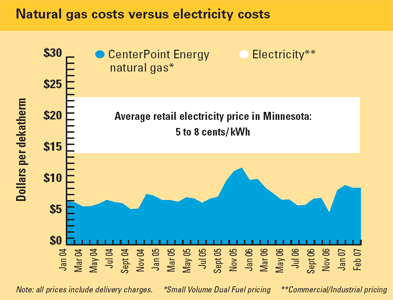Electric Companiy Commercial With the Easy Choice
The browser you are using is out of date and will soon be unsupported.
Please update to the latest version or view our site in another browser.
Page Content To make decisions more complicated, varying billing structures and pricing options make it challenging to understand charges and effectively compare electricity costs to natural gas. The information that follows will help your business or organization sort through the options and make informed decisions. As you will read, historically natural gas has been an excellent energy value and, for most applications, continues to be a better choice than electricity. Because electricity is billed in kilowatt hours (kWh) and natural gas in therms, it can be challenging to compare costs. Delivery and other charges make it even more difficult to accurately assess cost differences. The following table adjusts for the disparities, showing actual prices for natural gas and electricity for Minnesota commercial/industrial customers. As illustrated, even when a range of electric prices are considered, natural gas prices are consistently two to three times lower than electric prices. In fact, when all charges are considered, for a $0.06 per kilowatt hour (kWh) electricity rate to be competitive, natural gas would have to cost $1.77 per therm. Historically and currently, natural gas costs are well below that price. Even the highest commercial/industrial natural gas firm rate on record is only $1.38 per therm. The higher cost was the result of 2005's unusually active and destructive hurricane season. See Table 1 below for an electric versus natural gas price comparison. Another consideration is that electric utilities nationwide are projecting significantly increased costs as they update aging infrastructure to accommodate increased demand. Those costs will be passed along to the consumer and could even widen the gap between natural gas and electric costs. Table 1 Click to view natural gas costs versus other fuels Understanding your utility bill Do you know how much your company or organization is paying for utilities? It's not enough to simply compare kilowatt and therm unit rates. As you can see in the actual bills below (see Tables 2 and 3), there are a variety of charges added to basic costs that can make a big difference to your bottom line. What's your bottom line? Table 2 Sample electricity bill Charges and rates may vary by utility. Type of charge Qty Unit rate Total cost Energy charge (kWh) Energy charge 134,400 $0.039904 $5,363.10 Demand charge (kW) Demand charge 273 $6.610000 $1,804.53 Interim rate adjustment Interim rate adjustment $506.66 Environment improvement (kWh) Environment improvement rider 134,400 $0.000610 $81.98 Environment improvement (kW) Environment improvement rider 273 $0.250110 $68.28 Fuel cost adjustment (kWh) Fuel cost adjustment 134,400 $0.000255 $34.25 Resource adjustment Resource adjustment $235.84 Sum of costs $8,094.64 To determine how much you are paying per kWh: Divide sum by total kWh $8,094 - 134,400 Total cost per kWh $0.0602 Taxes, city fees, basic service charges back to top Table 3 Sample natural gas bill Charges and rates may vary by utility. Type of charge Qty Unit rate Total cost Delivery charge (therms) Delivery charge 1524 $0.11274 $171.82 Cost of gas (therms) Cost of gas 1524 $0.76393 $1,164.23 Interim rate adjustment 1524 $0.025255 $38.49 Sum of costs $1,458.86 To determine how much you are paying per therm: Divide sum by total therms $1,458.86 - 1,524 Total cost per therm $0.9573 Taxes, city fees, basic service charges To take it a step further, use the following equation to convert your actual kWh usage to therms: 1 kWh = 3,413 Btu = .0341 therms Price of energy is one factor for determining fuel choice. But, it's also important to consider price in the context of efficiency. The example - (Table 4) below compares an electric and natural gas heating system. Even with the efficiency factor difference, the lower cost of natural gas makes it a much better choice. Use this table to help make comparisons in your facility. Table 4 Commercial building with a 2 MM Btu heating load Electric equipment Natural gas equipment Output - kWh : Btu* 586 2,000,000 Efficiency factor .95 .80 Input - kWh : Btu 616.8 2,500,000 Annual operating hours 4,680 4,680 Load factor 0.35 0.35 Annual input - kWh : Therms 1,010,378 40,950 Unit energy cost - $/kWh : $/Therms $.06 $.96 Annual energy cost $60,623 $39,312 Annual savings with gas $21,311 Percent saved with gas 35% Incremental gas equipment cost $ 12,500 Payback .6 years *1 Therm = 100,000 Btu = 29.3 kWh Environmental impact is another important consideration when choosing fuels. As you can see in (Table 5) below, the significant differences between natural gas and electricity make natural gas the better choice for the environment. Table 5 Natural gas Electricity 90% efficient - it takes far less energy to extract from its source and provide to user 27% efficient - largely due to the energy lost in electric generation Lower greenhouse gas, sulfur dioxide, nitrogen oxide emissions and no mercury emissions Higher greenhouse gas, sulfur dioxide, nitrogen oxide and mercury emissions Burns more cleanly than other fossil fuels *Minnesota Pollution Control Agency,www.pca.state.mn.us,Sept. 8, 2006 back to top As shown in the examples provided, historical and current natural gas prices are significantly lower than the average retail electricity price. Natural gas remains the best value and best all-around energy choice. When you choose natural gas for your facility, you are making a wise decision for your bottom line and the environment. Natural Gas and Electricity
Natural gas is your best energy value
 Remember when energy choices were easy? Electricity was used for lighting, electronics and motors. For heating, the obvious choice was natural gas. In today's changing energy market, technological innovations and fluctuating energy costs are causing some decision makers to rethink energy options.
Remember when energy choices were easy? Electricity was used for lighting, electronics and motors. For heating, the obvious choice was natural gas. In today's changing energy market, technological innovations and fluctuating energy costs are causing some decision makers to rethink energy options. The cost difference

To find out how much you are paying for your utilities, take a closer look at your bills and, using the sample bills below (see Tables 2 and 3) as a guide, calculate your total cost per kWh and therm. Then take a second look at Table 1. How much less are you paying for natural gas than electricity?
Roll your mouse over the links below for more detailed information.
The amount of electricity used in kWh multiplied by electric utility's energy charge price.
The greatest 15-minute average kW peak demand that occurred during the billing period, multiplied by electric utility�s demand charge price, which is adjusted seasonally. Note: This charge is to help maintain sufficient generation and distribution capabilities to meet customer demand.
After a utility has filed for a rate increase, this amount reflects potential cost increases. If the rate increase is reduced, a portion of this amount will be refunded.
Fee applied for environmental improvement projects, based on energy usage.
Fee applied for environmental improvement projects, based on peak demand.
An adjustment for the fuel costs required to generate electric power. This amount fluctuates based on the monthly market price.
Reflects energy initiative expenses, including costs for the Conservation Improvement Program, Renewable Development Fund, Renewable Cost Recovery and State Energy Policy charges. Note: Taxes, city fees, basic service charges apply.
Additional charges for having natural gas service. All customers pay these fees, regardless of electricity provider.
Roll your mouse over the links below for more detailed information.
Amount of natural gas used multiplied by gas utility's delivery charge price.
Amount of natural gas used multiplied by gas utility's wholesale price of natural gas and transportation costs. This cost is passed through to the customer without mark-up. The cost per therm varies, based on market prices. Interim rate adjustment
After a utility has filed for a rate increase, this amount reflects potential cost increases. If the rate increase is reduced, a portion of this amount will be refunded. Note: Taxes, city fees, basic service charges apply.
Additional charges for having natural gas service. All customers pay these fees, regardless of natural gas provider.
Example: 134,000 kWh x .0341 = 4,587 therms
Add efficiency to the equation
Space heating comparison Natural gas is cleaner and greener
Coal combustion to produce electricity is the biggest source of many pollutants in Minnesota* Natural gas - for yesterday, today and tomorrow
galliherthantly62.blogspot.com
Source: https://www.centerpointenergy.com/en-us/Services/Pages/natural-gas-electricity-cost-comparison.aspx?sa=mn&au=bus
0 Response to "Electric Companiy Commercial With the Easy Choice"
Post a Comment